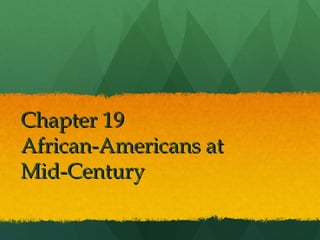
mrdines 8th history HistoryAlive! Chapter 20 Slave Life
- 2. North and South, Slave and Free Location determined African-American living conditions Free blacks had SOME rights; slaves had NONE
- 3. Slaves’ Legal Status Slaves were property; slaveholders had complete control Beaten, sold, even kill slaves Slaves have nothing
- 4. Rural and Urban Slaves Majority of slaves worked in rural setting Small number of slaves worked in cities; did not get to keep their wages Urban slaves had more “freedom” than rural slaves
- 5. Free Blacks in the South, part 1 Free blacks held normal jobs Free blacks viewed as dangerous; had restricted rights No guns, could not travel freely, certain jobs off limits
- 6. Free Blacks in the South, part 2 Had more rights than southern blacks, but not equality Discrimination – unequal treatment based on race, gender, religion, etc. Segregation – separation of groups based on race
- 7. Free Blacks in the South, part 2 Difficult to find jobs; worked low paying jobs Denied entry into churches Organized to protest unfair treatment: National Council of Colored People NAACP – National Association for the Advancement of Colored People (founded in 1909; first use of ‘people of color)
- 8. Economics of Slavery, part 1 Only a small number of farmers/planters owned slaves Cotton influenced slavery Cotton made many southern wealthy Cotton gave southern states economic strength
- 9. Economics of Slavery, part 2 Economy depended on slaves to harvest cotton Slaves became more valuable as cotton prices rose Increased value led to better treatment of slaves Expanding market prevented slaves from ever earning freedom
- 10. Controlling Slaves, part 1 Slavery only worked if slaves were forced to submit Physical punishment was often avoided; left slaves less likely to work Slaves treated as children; forced to depend on owners Slaves knew nothing of outside life Slave-breakers taught slaves to obey
- 11. Controlling Slaves, part 2 Fear, violence, and overwork used to break slaves Slaves never know how long they would work or when the next beating was coming Idea was to keep slaves tired, hopeless, and broken